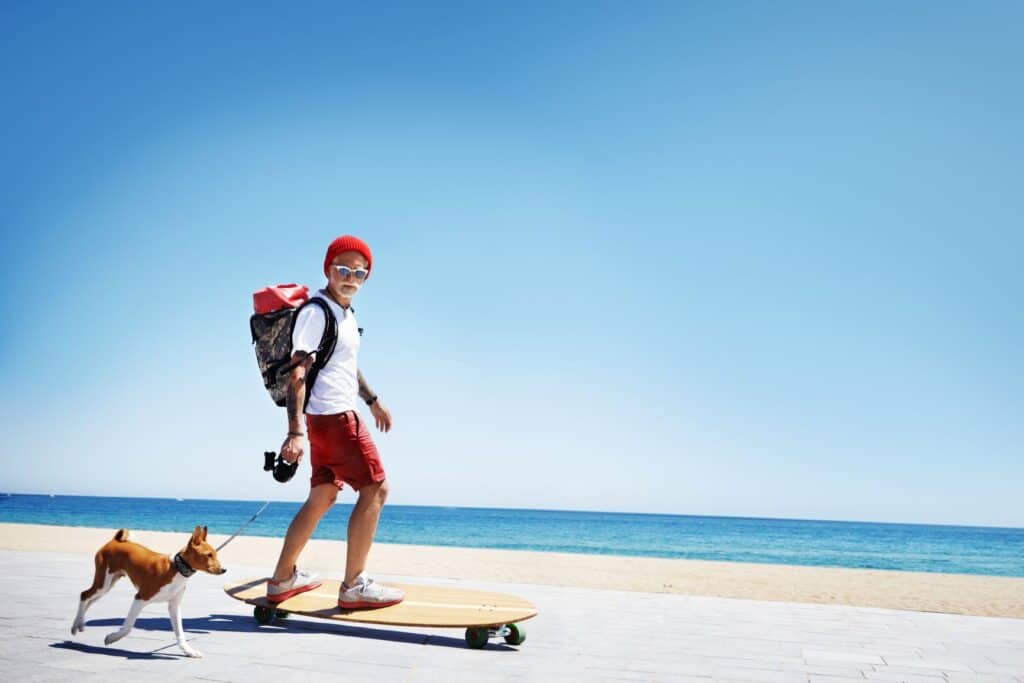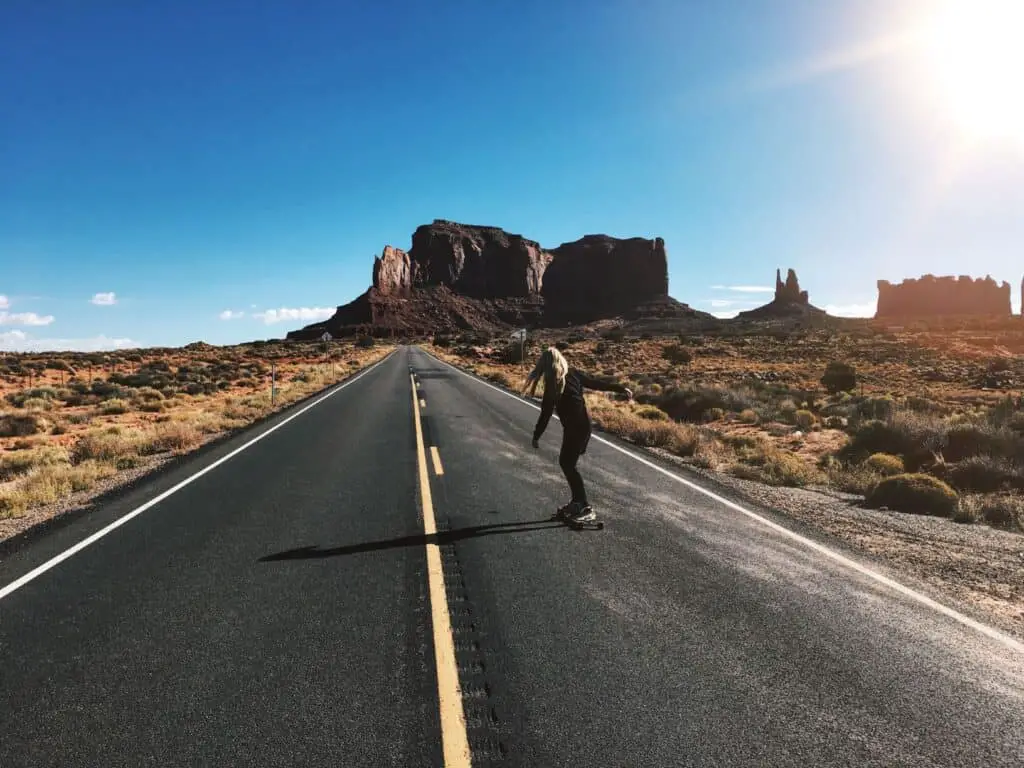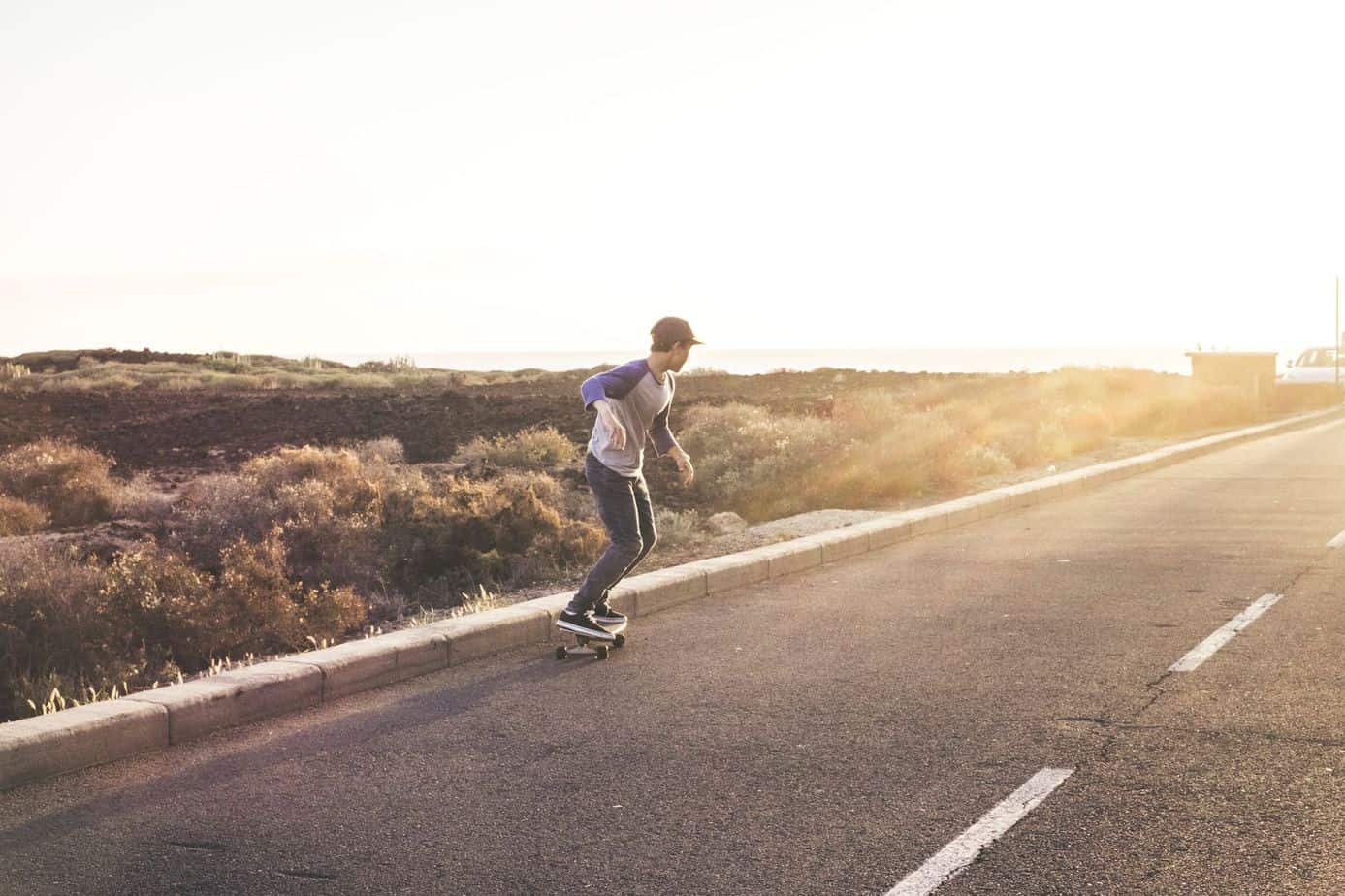Riding a longboard has some stylistic differences from riding a skateboard. Most beginners have questions about these styles. One of the most common questions is, “What is longboard carving?”
Longboard carving essentially refers to the S-shape pattern that you see people make with their longboards. While it may look easy from afar, it takes a bit of practice for anyone to perfect it. Once you learn how to do it properly, no one stops you from carving down a hill and getting the ultimate thrill.
Carving is pretty common in snowboarding and surfing as well. So, if you haven’t tried those either, it is best to start with longboard carving. It is safer and offers you better control, so risks are minimized if you do it right.
What Exactly Is Longboard Carving?
You might have seen people enjoying their time on a longboard while strolling in your neighborhood park. Seeing them casually drift on their boards and pulling different kinds of stunts is undoubtedly fun. Being able to go ahead and do these tricks yourself is even better.
One of the primary skills to learn as a beginning longboarder is how to carve efficiently with your longboard. Longboard carving helps set you up to pull more extreme stunts with your longboard.
However, if you’re not someone who wants to get into the extremities, then longboard carving is the perfect option for you. With longboard carving, you get to move in a rhythm-like pattern, taking in the wind and enjoying the feeling of the fluid ride.
Why Should You Learn Carving?
Carving means to create curves with an item you’re making use of. Here we are talking about longboard carving. That is not the only type of carving you will hear of.
While carving is a renowned activity for longboarding, it is also extremely common for surfers and snowboarders.
You might be thinking that carving is the only thing that you can do with longboards. That is not true at all. There are other things, such as freeriding, freestyling, cruising, dancing, and downhill that you can do with your longboard.
Want to know why longboarding is better than skateboarding? Read this.
Each of these offers you a different level of longboard experience. Carving happens to be something that you get to learn in the early stages of longboarding.
Speed Control
One of the main reasons to learn how to carve is to control your longboard’s speed better. With the S-shape turns you make as you carve, you’re able to reduce your speed significantly.
This helps avoid any unwanted accidents and allows you to have control over your longboard as opposed to the other way round. Good speed control offers users more stability and keeps them on their board for longer.
Restrict Speed Wobbles
Another thing to note is that learning how to carve efficiently can help ensure you stop any speed wobbles. Speed wobbles mostly happen when your longboard frame is misaligned, causing your wheel to make turns that you don’t plan on making.
When you know how to carve, you will get a hold of the situation and ensure that you cut down the speed to steady yourself. You can do this by catching the wobble and carving it out.
Stepping Stone To Slides
Carving proves to be a fundamental step for many other longboarding styles. A popular one is sliding. To be able to slide, you need to ensure that you can carve the right way.
It proves to be a stepping stone for you that will eventually help you a great deal when you get into learning something more extreme, such as sliding on your longboard. A good grip on carving is essential for you to move forward with this.

Determining The Type Of Longboard Rider You Are
To ensure that you have the basics right, you first need to figure out what type of rider you are. There are two main types that you can fall under.
Either you’re the regular rider or the goofy rider. You might want to be termed regular, but it has nothing to do with your capabilities. Instead, you get to be termed as either one depending on the placement of your feet.
For instance, if you place your left foot in the front and face the right while you board, you are a regular rider. However, if you put your right foot in the front and face the left while you board, you are a goofy rider.
Once you have determined this, it will be easier for you to carve the right way. Otherwise, you might follow instructions that are not meant for you.
Don’t worry. It is not that difficult to get the hang of carving on a longboard either way.
Basic Steps Of Longboard Carving
Follow these four steps, and you will soon find yourself carving like a professional with your longboard.
- Keep your body straight. Your posture is extremely important. You do not want to be slouching on your longboard. With your body straight, bend your knees a little.
- With your feet firmly on your longboard, lean towards one of your sides. You should feel like you’re being pushed, but with you in control. This step is easier if your board offers you the right flex. We will get to what flex is all about in a bit. As you lean, your board is more likely to flex downwards as well.
- Try to push yourself up and then straighten up as you do so. As you do this, you will also have to turn in the other direction. Keep in mind that you have to create an S-shape or a wave on the ground. So, you will be forming a pattern where you will be moving from left to right, carving through the path.
- It all comes with practice. Keep repeating these steps to master the art of carving on a longboard. It will take a few tries, but you will surely get the hang of it.
Two Types Of Carving Turns To Practice
There is much more to carving than just making waves on the ground.
Nowadays, you will find that carving has a variation of its own. One of the more popular thrown around terms is “mellow riding.” Mellow riding is carried out using a swinging movement. For each type of carving, one of the main things you will need to learn is how to carve efficiently.
There are two types of carving turns that are commonly used for longboarding.
These include toe-side and heel-side carving turns.
Toe-Side Carving Turns
Toe-side carving turn refers to when you put pressure on your front toe to make the turns. This will allow you to steer your longboard in whichever direction you are going for.
The direction mainly depends on your footing. Regular riders will drift towards the right when they do this, whereas goofy riders are bound to drift towards the left.
Heel-Side Carving Turns
Heel-side carving turn refers to when you put pressure on your heels to make the turns. This will also enable you to change your directions as you dig your heel into your board.
Again, keep in mind the type of rider you are. For regulars, this movement will take you to the left. Whereas, for the goofy riders, this will take them to the right.
How To Effectively Shift Weight While Carving
One of the most important things that play a role in your longboard carving adventures is your ability to shift your weight. You must learn how to effectively shift your weight as you go into carving.
Many people ignore the idea that you have to use your entire body to make the right movements for the weight shift. Only focusing on a selected area of your body is not the right way to go about this.
Remember that you don’t only have to move from right to left to carve with your longboard. Instead, you will also need to ensure that you gather enough energy to make your longboard run continuously, without having to touch your feet on the ground. While your feet play an important role in doing this, they are not the only parts of your body that you need to perfect your carving.
Imagine a full-body movement when you think of carving with your longboard. Immerse in the feeling of flowing with your longboard rather than continually focusing on just your feet.
Your entire body will start operating in a rhythm as you create a smooth-flowing movement while carving with your longboard.
To make this effective, you need to ensure you’re making use of your entire body, including your head, hips, legs, and shoulders. Think of creating a wave-like pattern with your body as you go about carving with your longboard.
Don’t just move your heels and toes. Instead, focus on your direction with your head, rotate your shoulders, and align your entire body with these movements. You will find yourself ultimately in a constant rhythm while you’re on your board.

Choosing The Ultimate Longboard For Carving
You will have to take a look at quite a few features to ensure that you have the perfect one for your carving needs.
If you’re looking to buy a longboard for carving, read “Are Zumiez Skateboards Good?“
Let’s take a look at some features for good longboard carving.
Long Wheelbase
As a beginner, you should go for a long wheelbase of at least 25”. A longer wheelbase will allow you to have greater control over your movements as it will offer you additional stability. This pintail bamboo longboard on Amazon is a great example.
You will be able to get the right experience without worrying about excessive speed as you try to go down the hill. This will also help you limit the speed wobbles that are a common occurrence when longboarding.
Type Of Mount
When it comes to the type of mount, going for the mid-size one proves to be the ideal choice. From 32 inches to a maximum of 42 inches deck, you can choose any kind of size in between. You don’t want to limit your movements by getting too large of a deck. Moreover, you also don’t want to hinder your movements by getting too small of a deck. A medium-size works just right for carving on your longboard.
Style Of Deck
There are two variations available for you to choose from. One is the top-mount deck, and the other is the drop-through board.
Top-mount decks offer you greater speed and quicker movements when carving. On the other hand, drop-through boards offer you stability as you have better control of your speed.
So, if you are a beginner, it is advisable to go for a drop-through board. However, if you have sufficient practice, choosing a top-mount deck will give you the right kind of thrill.
Truck Width And Height
Another thing to consider is the height and width of the trucks. When it comes to the width, you can go for a safer option that comes with more width or go for lesser width and better turns. There is a trade-off between the two. So, you should choose one that makes you comfortable.
When it comes to longboard height, you should always go for more height for carving. The larger the difference between the wheels and the deck, the better the carving experience will be.
Height will allow you to make better curves and get more movement with your board. But height also means that things might get less stable at higher speeds. For carving, looser trucks make the entire experience worthwhile.
Concave And Camber Deck
A camber deck is an ideal choice for carving. It features a curvature with the highest placement in the middle. The way it is designed allows your carving experience to get better. As you lower yourself down and apply pressure when making a turn, you immediately sprung back up with the help of the design.
Another option available to you for carving is the concave board. This one offers you exception placement for your feet. So, you will be much more at ease when making turns as you will have a better grip on your longboard.
Flex
Flex is the movement that will bring you back up and uplift your entire carving experience. It helps you push yourself up and continue making your curve. Your longboard should have enough flex to make your experience better.
Tips To Remember While Carving
Finally, we have some tips for you to remember as you go about learning longboard carving.
Try Not Lifting Your Toes Or Heels
Try to keep your feet on your board. Don’t lift your heels when you’re pressing on your toes. Don’t lift your toes when you’re pressing on your heels.
This will only get you out of balance. Practice keeping your heels and toes on your board as you make your turns and push down. It will enable you to stabilize yourself and help you bounce back up when you’re turning.
Practice On A Smooth And Predictable Surface
As you start, you shouldn’t go in with challenging courses. Instead, choose a surface you’re aware of to be smooth. Unpredictable shifts in the surface will cause you to lose control if you’re starting. Try to avoid unknown locations or uneven surfaces.
A Location With Plenty Of Width Is Ideal
Using a location that offers you generous width is perfect when learning longboard carving. It allows you to make larger S-shaped patterns and make mistakes along the way without hitting a wall.
The wider the location, the better it is for you to test out your skills. The narrower the location is, the more cautious you will get about not bumping into the pavement. This will limit your movement, as well.
It Takes Practice To Perfect Carving
If you’re finding it difficult, then don’t worry. It takes a lot of practice to get the hang of this. So, stay focused, use the right techniques, and keep practicing to get your carving right. It’s all about putting in the effort.
Conclusion
Longboard carving is a fun activity to learn. You get to enjoy carving on its own, but it also allows you to expand your longboarding skills. Once you perfect this with practice, there is no one stopping you from mastering all the other types of longboard activities out there.
If this article was helpful, sign up for our Newsletter for more great content.

